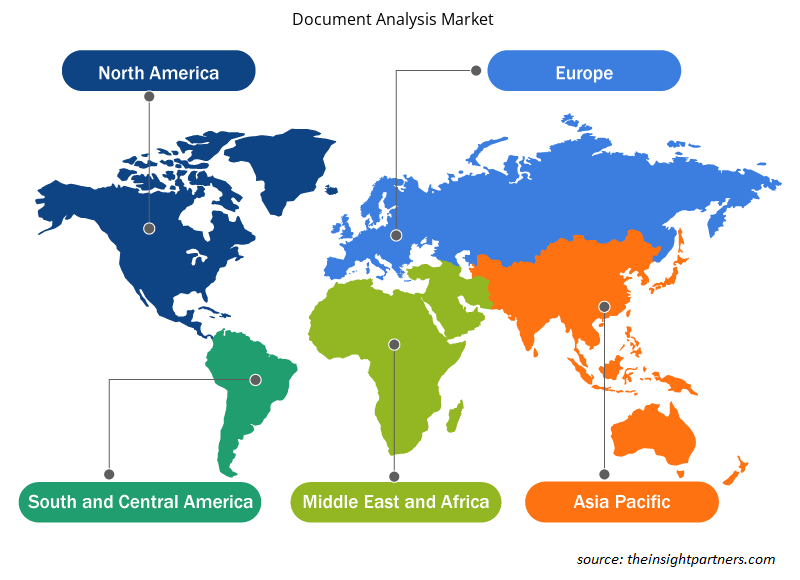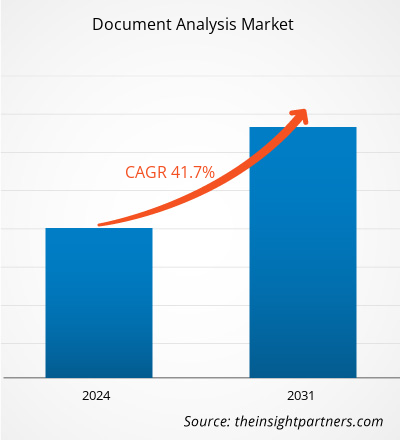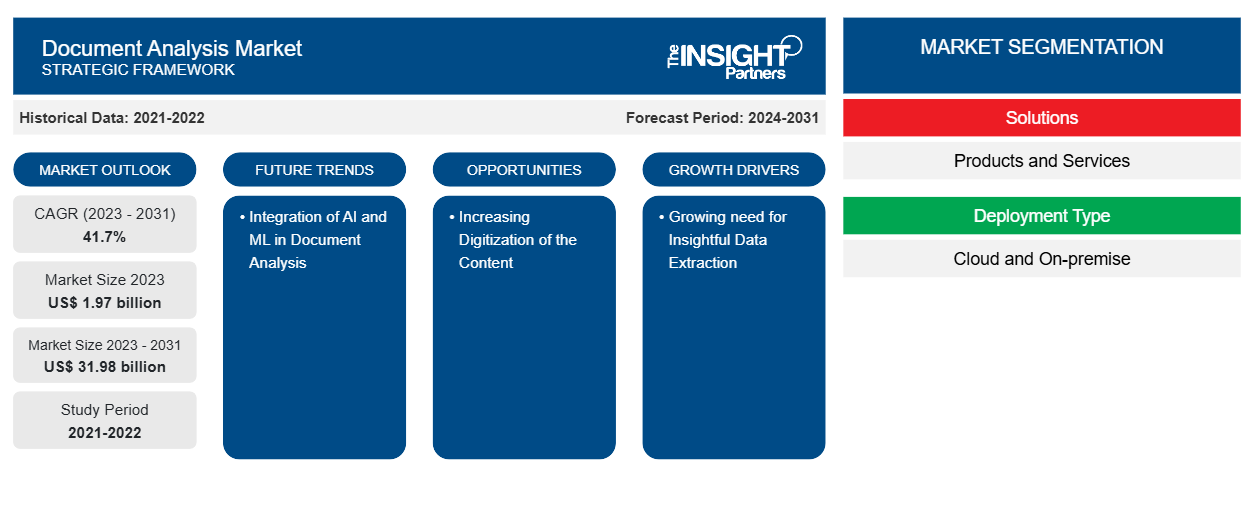Der Markt für Dokumentenanalysen soll von 1,97 Milliarden US-Dollar im Jahr 2023 auf 31,98 Milliarden US-Dollar im Jahr 2031 anwachsen. Der Markt für Dokumentenanalysen soll zwischen 2023 und 2031 eine durchschnittliche jährliche Wachstumsrate (CAGR) von 41,7 % verzeichnen. Die zunehmende Tendenz zur Digitalisierung von Inhalten und die Notwendigkeit, daraus Erkenntnisse abzuleiten.
Dokumentenanalyse Marktanalyse
Die Dokumentenanalyse bietet Unternehmen einen strukturierten Ansatz, um wertvolle Erkenntnisse effizient aus verschiedenen Dokumenten zu gewinnen. Unternehmen können versteckte Muster erkennen und fundierte Entscheidungen treffen, indem sie Techniken wie Inhaltsanalyse einsetzen und Tools wie OCR und Software zur qualitativen Datenanalyse nutzen.
Marktübersicht zur Dokumentenanalyse
Die Dokumentenanalyse ermöglicht es Benutzern, Daten mit variablen Daten automatisch zu prüfen. Sie ermöglicht es Einzelpersonen, wertvolle Erkenntnisse zu gewinnen, Muster zu erkennen und Schlussfolgerungen aus Texten zu ziehen, die von historischen Manuskripten bis hin zu zeitgenössischen digitalen Dokumenten reichen. Die manuellen Prozesse sind weder 100 % genau noch kosteneffizient, weshalb verschiedene Organisationen die Dokumentenanalyse einsetzen. In der Geschäftswelt ist sie für Finanzanalysen, Vertragsprüfungen, Marktforschung und Wettbewerbsinformationen von entscheidender Bedeutung. Die Prüfung von Geschäftsdokumenten wie Finanzberichten, Verträgen und Marktstudien kann Unternehmen dabei helfen, fundierte Entscheidungen zu treffen, Chancen zu nutzen und Risiken zu erkennen.
Passen Sie diesen Bericht Ihren Anforderungen an
Sie erhalten kostenlos individuelle Anpassungen an jedem Bericht, einschließlich Teilen dieses Berichts oder einer Analyse auf Länderebene, eines Excel-Datenpakets sowie tolle Angebote und Rabatte für Start-ups und Universitäten.
-
Holen Sie sich die wichtigsten Markttrends aus diesem Bericht.Dieses KOSTENLOSE Beispiel umfasst eine Datenanalyse von Markttrends bis hin zu Schätzungen und Prognosen.
Markttreiber und Chancen für die Dokumentenanalyse
Zunehmende Digitalisierung des Inhalts zur Förderung des Marktes
Unternehmen auf der ganzen Welt digitalisieren ihre Inhalte, um ihre Abläufe zu optimieren, Kosten zu senken und ihr Endergebnis zu verbessern. Die Dokumentendigitalisierung hilft Unternehmen dabei, Papierdokumente in digitale Formate umzuwandeln, die online gespeichert, bearbeitet, abgerufen und geteilt werden können. So stellte eine Studie im Oktober 2022 fest, dass indische Unternehmen entschlossen sind, ihre Investitionen in diese Funktionen in den nächsten 12 Monaten um 25 % zu erhöhen. An der Umfrage nahmen 150 Geschäftsentscheider aus Australien, Neuseeland, Indien und Singapur teil. Unternehmen verlassen sich zunehmend auf digitalisierte Dokumenten-Workflows und entscheiden sich für diese. Die Digitalisierung und Erstellung von Inhalten hilft Unternehmen dabei, ihre Arbeitsabläufe zu optimieren, ihre Sicherheit zu verbessern, ihre Kosten zu senken und ihre Produktivität zu steigern. So hilft die Digitalisierung aller Inhalte Unternehmen dabei, komplexe Dokumente zu automatisieren, zu analysieren und zu vergleichen – absolut zuverlässig, automatisiert und unabhängig vom Format und der Struktur der zu prüfenden Dateien. Die Digitalisierung von Inhalten ermöglicht Stichprobenprüfungen, die dabei helfen, sofortige, aussagekräftige Erkenntnisse zu gewinnen. So treibt die zunehmende Digitalisierung der Inhalte das Wachstum des Dokumentenanalysemarktes voran .
Wachsender Bedarf an aufschlussreicher Datenextraktion.
Der effiziente Umgang mit Daten ist entscheidend für die Produktivität und den Erfolg eines Unternehmens. Die Dokumentenanalyse ermöglicht die Rationalisierung dokumentenbezogener Prozesse, sodass Unternehmen wertvolle Erkenntnisse gewinnen, ihren Entscheidungsprozess verbessern und Arbeitsabläufe optimieren können. Sie automatisiert die Extraktion relevanter Informationen aus unstrukturierten Dokumenten wie Rechnungen, Verträgen und Berichten. Durch den Einsatz fortschrittlicher Algorithmen werden wichtige Datenpunkte (z. B. Rechnungsbeträge, Fälligkeitsdaten, Lieferantendetails) identifiziert und Datenbanken oder Unternehmenssysteme befüllt. Stellen Sie sich beispielsweise eine Kreditorenbuchhaltungsabteilung vor, die täglich Hunderte von Rechnungen erhält. Dokumentenanalysesoftware kann Rechnungsdaten schnell extrahieren, wodurch manuelle Dateneingabefehler reduziert und die Zahlungsabwicklung beschleunigt wird.
Dokumentenanalyse Marktbericht Segmentierungsanalyse
Wichtige Segmente, die zur Ableitung der Marktanalyse zur Dokumentenanalyse beigetragen haben, sind Lösungen, Bereitstellungstyp, Organisationsgröße und Branche.
- Basierend auf Lösungen ist der Markt für Dokumentenanalyse in Produkte und Dienstleistungen segmentiert.
- Basierend auf dem Bereitstellungstyp ist der Markt für Dokumentenanalyse in Cloud und On-Premise segmentiert.
- Basierend auf der Unternehmensgröße ist der Markt für Dokumentenanalyse in Großunternehmen sowie kleine und mittlere Unternehmen (KMU) segmentiert.
- Basierend auf Branchenvertikalen ist der Markt für Dokumentenanalyse in BFSI, Regierung, Gesundheitswesen, Einzelhandel, Fertigung und andere segmentiert.
Dokumentenanalyse Marktanteilsanalyse nach Geografie
Der geografische Umfang des Marktberichts zur Dokumentenanalyse ist hauptsächlich in fünf Regionen unterteilt: Nordamerika, Asien-Pazifik, Europa, Naher Osten und Afrika sowie Südamerika/Süd- und Mittelamerika. Unternehmen in ganz Nordamerika verwenden zunehmend digitale Dokumente und benötigen daher Lösungen zur Dokumentenanalyse. Darüber hinaus verwenden wachsende Volkswirtschaften wie Europa und der Asien-Pazifik-Raum Dokumentenanalysen.
Regionale Einblicke in den Markt für Dokumentenanalyse
Die regionalen Trends und Faktoren, die den Dokumentenanalysemarkt während des Prognosezeitraums beeinflussen, wurden von den Analysten von Insight Partners ausführlich erläutert. In diesem Abschnitt werden auch die Marktsegmente und die Geografie von Dokumentenanalysen in Nordamerika, Europa, im asiatisch-pazifischen Raum, im Nahen Osten und Afrika sowie in Süd- und Mittelamerika erörtert.

- Erhalten Sie regionale Daten zum Dokumentenanalysemarkt
Umfang des Marktberichts zur Dokumentenanalyse
| Berichtsattribut | Details |
|---|---|
| Marktgröße im Jahr 2023 | 1,97 Milliarden US-Dollar |
| Marktgröße bis 2031 | 31,98 Milliarden US-Dollar |
| Globale CAGR (2023 - 2031) | 41,7 % |
| Historische Daten | 2021-2022 |
| Prognosezeitraum | 2024–2031 |
| Abgedeckte Segmente |
Nach Lösungen
|
| Abgedeckte Regionen und Länder |
Nordamerika
|
| Marktführer und wichtige Unternehmensprofile |
|
Dokumentenanalyse Marktteilnehmerdichte: Die Auswirkungen auf die Geschäftsdynamik verstehen
Der Markt für Dokumentenanalysen wächst rasant, angetrieben durch die steigende Nachfrage der Endnutzer aufgrund von Faktoren wie sich entwickelnden Verbraucherpräferenzen, technologischen Fortschritten und einem größeren Bewusstsein für die Vorteile des Produkts. Mit steigender Nachfrage erweitern Unternehmen ihr Angebot, entwickeln Innovationen, um die Bedürfnisse der Verbraucher zu erfüllen, und nutzen neue Trends, was das Marktwachstum weiter ankurbelt.
Die Marktteilnehmerdichte bezieht sich auf die Verteilung der Firmen oder Unternehmen, die in einem bestimmten Markt oder einer bestimmten Branche tätig sind. Sie gibt an, wie viele Wettbewerber (Marktteilnehmer) in einem bestimmten Marktraum im Verhältnis zu seiner Größe oder seinem gesamten Marktwert präsent sind.
Die wichtigsten auf dem Markt für Dokumentenanalysen tätigen Unternehmen sind:
- AntWorks
- Automation Anywhere, Inc
- Celaton
- Datamatics Global Services Limited
- Absauganlagen
- HCL Technologies
Haftungsausschluss : Die oben aufgeführten Unternehmen sind nicht in einer bestimmten Reihenfolge aufgeführt.

- Überblick über die wichtigsten Akteure auf dem Markt für Dokumentenanalyse
Marktnachrichten und aktuelle Entwicklungen zur Dokumentenanalyse
Der Markt für Dokumentenanalyse wird durch die Erhebung qualitativer und quantitativer Daten nach Primär- und Sekundärforschung bewertet, die wichtige Unternehmensveröffentlichungen, Verbandsdaten und Datenbanken umfasst. Im Folgenden finden Sie eine Liste der Entwicklungen auf dem Markt:
- Im September 2023 führte Ocrolus eine vollautomatische Dokumentenverarbeitung ein, die in Sekundenschnelle Erkenntnisse liefert. Das eingeführte Produkt Instant ist ein KI-gestütztes Serviceangebot, das es Kreditgebern ermöglicht, Kontoauszüge und andere Finanzdokumente effizienter als je zuvor zu analysieren.
(Quelle: Ocrolus, Pressemitteilung, 2023)
- Im Juli 2022 brachte das kanadische Unternehmen für Dokumentenqualitätskontrolle GlobalVision die neueste Innovation in der Branchen-Compliance-Korrekturtechnologie mit dem Namen Text Inspection 2 auf den Markt. Dieser Algorithmus, ein Update des Cloud-basierten Korrektursystems Verify des Unternehmens, setzt einen neuen Standard für Geschwindigkeit und Genauigkeit beim Lesen und Analysieren digitaler Dokumente.
(Quelle: Palo Alto, Pressemitteilung, 2021)
Dokumentenanalyse – Marktbericht – Abdeckung und Ergebnisse
Der Bericht „Marktgröße und Prognose zur Dokumentenanalyse (2021–2031)“ bietet eine detaillierte Analyse des Marktes, die die folgenden Bereiche abdeckt:
- Marktgröße und Prognose auf globaler, regionaler und Länderebene für alle wichtigen Marktsegmente, die im Rahmen des Projekts abgedeckt sind
- Marktdynamik wie Treiber, Beschränkungen und wichtige Chancen
- Wichtige Zukunftstrends
- Detaillierte PEST/Porters Five Forces- und SWOT-Analyse
- Globale und regionale Marktanalyse mit wichtigen Markttrends, wichtigen Akteuren, Vorschriften und aktuellen Marktentwicklungen
- Branchenlandschaft und Wettbewerbsanalyse, einschließlich Marktkonzentration, Heatmap-Analyse, prominenten Akteuren und aktuellen Entwicklungen
- Detaillierte Firmenprofile
- Historische Analyse (2 Jahre), Basisjahr, Prognose (7 Jahre) mit CAGR
- PEST- und SWOT-Analyse
- Marktgröße Wert/Volumen – Global, Regional, Land
- Branchen- und Wettbewerbslandschaft
- Excel-Datensatz
Aktuelle Berichte
Erfahrungsberichte
Grund zum Kauf
- Fundierte Entscheidungsfindung
- Marktdynamik verstehen
- Wettbewerbsanalyse
- Kundeneinblicke
- Marktprognosen
- Risikominimierung
- Strategische Planung
- Investitionsbegründung
- Identifizierung neuer Märkte
- Verbesserung von Marketingstrategien
- Steigerung der Betriebseffizienz
- Anpassung an regulatorische Trends























 Kostenlose Probe anfordern für - Markt für Dokumentenanalyse
Kostenlose Probe anfordern für - Markt für Dokumentenanalyse